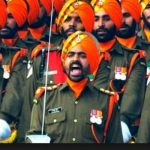MARUTHU PANDIYARS
Brothers Valiant who championed the South Indian Rebellion
Periya, the elder, Maruthu and Chinna, the younger, Maruthu, were two brothers born five years apart in 1748 and 1753, in the village of Mukkulam in the present-day Sivaganga District of Southern Tamil Nadu. Their parents were ordinary folk who belonged to the Thevar community, a warlike people, who had traditionally defied the imposition of de facto authority of the English East India Company (EIC) over their homeland under the patronage of the Nawab of Arcot, the Mughal vassal for the Carnatic Region, whose authority itself was not recognized by the people at large. The father, Mokka Palanisamy Thevar, having been in the service of the King of Sivaganga, the two children grew up as aids to the king, earning themselves proficiency in martial arts. They grew up to be tall and well-built young men with a reputation for exceptional physical courage. An extraordinary feat by them of saving the king’s life once when he was attacked by a wild tiger, led to their being bestowed upon with the title of ‘Pandiyars’ by the king.
In the year 1772, by when the two brothers had turned 24 and 19 each, a large force of the EIC attacked their kingdom, at the behest of the Nawab of Arcot, following their king’s refusal to pay taxes to him. Though the king and his army, with Maruthu Pandiyars as chieftains in its ranks, fought gallantly, they were outnumbered and overwhelmed by the Company’s forces and the king slain in battle. The Pandiyar brothers survived, and getting wind of a sinister plot by the Nawab to murder the queen and her infant daughter, they rescued and escorted them to a safe haven at Dindigul, out of reach of the Nawab.
While the Pandiyars went on to raise an army in exile to avenge the defeat, the queen, Rani Velu Nachiyar, an exceptionally intelligent and bold lady, determined to wrest her kingdom back, worked tirelessly using her diplomatic skills to find allies to fight the superior forces of the English Company. Eight years on, the Rani succeeded in garnering the support of Hyder Ali of Mysore, the arch enemy of the British and, in a well-planned operation, her army, led by the Pandiyars, attacked Sivaganga and liberated it from the occupying troops of the Nawab and the EIC. Crowned the Queen, she appointed the elder Pandiyar the Commander-in-Chief of her army and the younger one the Chief Minister. After being a benevolent ruler to her subjects for a decade, the Rani relinquished her throne, handing over the reins to her daughter, Princess Vellachi, who had come of age, in 1790. While an ageing Rani Velu Nachiyar passed away after six years, the Maruthu Pandiyar brothers continued to serve her daughter loyally, assuming the role of rulers, by default because of the inexperience of their young queen.
Parallel to the rivalry between the Kingdom of Sivaganga and the EIC during the latter half of 18th Century, the British had been facing constant hostility from various Poligars (regional chieftains), whose authority had held sway over much of the Tamil homeland for almost two hundred years. Although the EIC had succeeded in putting down the earliest Poligar challenge posed to them by Puli Thevar of Thirunelveli, the first of the great Poligar leaders in 1760s, trouble had been brewing between them and the defiant Poligar of Panchalamkurichi, Veerapandiya Kattabomman, towards the end of the century. With unity of purpose, Kattabomman found the Maruthu Pandiyars his natural allies. The EIC, which had been preoccupied with the Mysore Wars, turned its guns on Kattabomman, soon after their victory at Seringapattom and the killing of Tipu Sultan. With the fall of his fort imminent under attack by an overwhelmingly superior enemy force, Kattabomman was persuaded to escape by his two younger brothers, who fought a gallant rear-guard action to give him time to get away. However, with their penchant for bribing one or the other traitorous native rulers to betray their compatriots, the British successfully cornered Kattabomman and hanged him at Kayatharu on 16 October 1799. His two brothers, Oomadurai and Sevatia, taken prisoner, were imprisoned at Palayamkottai to await their execution.
Meanwhile, Maruthu Pandiyars, clearly foreseeing the inevitable plunge of the entire country into subjugation by a foreign power, if the British were permitted to have their way, began working on a pan-Indian movement to stem the tide of their imperialism. They tried to forge a grand alliance of the disaffected groups all across the peninsula. Besides all the Southern Poligars, the alliance generally included the Poligars of Dindigul, the Kurichias of Malabar, Dhondia Wagh of Bidnur, some Sardars of Nizam and even some of the Maratha chiefs including Daulat Rao Scindia. Unfortunately, lacking modern tools of communication, this popular, first-ever such anti-colonialist initiative anywhere in the Indian Subcontinent, which came to be referred to as the South Indian Rebellion, could only bring about widespread but isolated peasant uprisings lacking cohesiveness, all of which collapsed within a year in the face of the sustained military onslaught by the British.
Nevertheless, the year 1801 saw bloody fighting raging all across the South. Swinging into action early that year, Maruthu Pandiyars, with the benefit of experience of an abortive jail break they had staged earlier at Coimbatore to chasten the British, sprung Oomadurai and Sevatia from Palayamkottai prison. Those two took up the fight with renewed ferocity from their home turf at Panchalamkurichi with support from the Pandiyars, and intense fighting followed in what came to be known as the Second Poligar War. After a gallant last stand by Oomadurai and Sevatia, Panchalamkurichi fell in May 1801, though the brothers managed to escape and continued with guerrilla war. They would eventually be captured, brought to Panchalamkurichi and hanged.
In June 1801, Maruthu Pandiyars issued a proclamation of independence from the Tiruchi fort, exhorting all people of the land to rise above considerations of caste or creed and rise as one to fight against European domination; a first ever visionary act of the kind to have taken place in India until then. They fought on tenaciously, resorting often to guerrilla tactics, inflicting heavy casualties on the enemy, while bearing their own resolutely. The exasperated British inducted additional troops from Britain to counter this unprecedented challenge. Finally, after a bitter confrontation that lasted over a month, the Pandiyars were wounded and captured during a battle at Cholapuram on 19 October. Five days later, on 24 October 1801, they were publicly hanged at Tirupputhur Fort, along with their sons, grandsons and followers. Thus ended one of the bravest native resistances to British imperialism India ever witnessed. Sadly, the mainline historians who found favour with the officialdom in Delhi after independence, for whom no India existed south of the Vindhyas, abhorrently chose to ignore such magnificent struggles and sacrifices of the Southerners, while chronicling the anti-imperialist legacy of the country.
The Maruthu Pandiyar Memorial Pillar erected at Tirupatthur, where they were hanged and some statues in Sivaganga are all that remains today to remind us of the glorious legacy of the two valiant brothers. Every year, the people of Tamil Nadu commemorate their death anniversary by conducting a pooja at the temple at Kalaiyar Kovil, once the capital of the proud Kingdom of Sivaganga, where the brothers were based and their mortal remains lie buried.





👍
[…] historical associations and local tales persist. One such link connects the Kombai to the Marudhu Pandiar brothers, rulers of Sivavangai in Tamil Nadu, who launched one of the first formal declarations of […]
Thanks for the input.